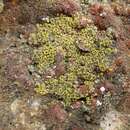pt-BR
nomes no trilho de navegação


Die Candelariales sind die einzige Ordnung der Unterklasse der Candelariomycetidae der Schlauchpilze (Ascomycota), deren Arten Flechten bilden.
Die Candelariales sind flechtenbildende Pilze, ihre Photobionten sind chlorococcale Grünalgen (Chlorophyta). Sie sind vorwiegend nitrophil (stickstoffliebend). Der Thallus ist verschieden geformt. Durch Pulvinsäure und deren Derivate ist er gelb bis orange gefärbt. Die Fruchtkörper sind am Thallus sitzende, gelbe bis orange Apothecien, deren Rand deutlich oder nur undeutlich ausgeprägt ist. Die Fruchtkörperwand wird durch dicht septierte, gedrehte Hyphen gebildet. Die Paraphysen sind meist einfach. Das Excipulum ist durchscheinend (hyalin), das Hymenium ist amyloid. Die Asci sind unitunicat und vom Candelaria-Typ: der untere Teil der apikalen Kuppel ist amyloid, es gibt ein breites apikales Kissen, es gibt häufig viele Sporen. Die Ascosporen sind hyalin, und nicht septiert, selten einfach septiert.[1]
Die Candelariales wurden erst 2007 mit zunächst zwei Gattungen (Candelaria und Candelarriella), die der von Hakulinen 1954 aufgestellten Familie Candelariaceae entsprechen, beschrieben.[2] Sie wurden anfangs keiner Unterklasse der Lecanoromycetes zugerechnet.[1] Die Ordnung wurde erst 2007 erstbeschrieben, Eriksson[3] führt die Gattungen noch bei den Lecanoraceae (Lecanorales), von denen sie sich morphologisch nicht abgrenzen lassen. Nach einer Überarbeitung der Systematik aller flechtenbildenden Pilze wurde die Ordnung in eine eigene Unterklasse, die Candelariomycetidae gestellt.[4] Nach Lücking und Mitarbeiter besteht die Ordnung aus zwei Familien mit vier bzw. einer Gattung:[4][5]
Die Candelariales sind die einzige Ordnung der Unterklasse der Candelariomycetidae der Schlauchpilze (Ascomycota), deren Arten Flechten bilden.
Candelariacea famîleyeke kuvan ji koma Candelariales e[2]. Li Kurdistanê du cureyên famîleyê dihên dîtin: Candelariella aurella û Candelariella xanthostigma.
Candelariacea famîleyeke kuvan ji koma Candelariales e. Li Kurdistanê du cureyên famîleyê dihên dîtin: Candelariella aurella û Candelariella xanthostigma.
The Candelariales are an order of fungi in the monotypic class Candelariomycetes. It contains the families Candelariaceae and Pycnoraceae.[1] The order was circumscribed by Jolanta Miadlikowska, François Lutzoni, and Helge Thorsten Lumbsch as part of a comprehensive phylogenetic classification of the kingdom Fungi published in 2007.[2] The class Candelariomycetes was created in 2018 by Hermann Voglmayr and Walter Jaklitsch.[3]
The Candelariales are an order of fungi in the monotypic class Candelariomycetes. It contains the families Candelariaceae and Pycnoraceae. The order was circumscribed by Jolanta Miadlikowska, François Lutzoni, and Helge Thorsten Lumbsch as part of a comprehensive phylogenetic classification of the kingdom Fungi published in 2007. The class Candelariomycetes was created in 2018 by Hermann Voglmayr and Walter Jaklitsch.
Candelariaceae
Les Candelariales sont un ordre de champignons lichénisés dans la classe des Lecanoromycetes. L'ordre est monotypique, ne comportant que la seule famille des Candelariaceae. Il s'agit de lichens au thalle encroûtant, fruticuleux ou foliacé, de couleur dominante jaune, variant du jaune-verdâtre à l'orange, particulièrement représentés sous des climats tempérés froids ou polaires[1].
La séparation de cet ordre, basée sur plusieurs études de phylogénie moléculaire, est tardive : suggérée en 2005[2], puis confirmée en 2007[3], une publication de la même année suggérant même d'en faire une sous-classe indépendante (Candelariomycetidae) au sein des Lecanoromycetes[4], elle ne fut officialisée qu'un peu plus tard, toujours en 2007[5]. La sous-classe des Candelariomycetidae n'est pour l'instant pas validée, et les Candelariales constituent aujourd'hui un ordre incertae sedis, c'est-à-dire qui n'est actuellement rattaché à aucune des trois sous-classes reconnues des Lecanoromycetes[6].
Candelariaceae
Les Candelariales sont un ordre de champignons lichénisés dans la classe des Lecanoromycetes. L'ordre est monotypique, ne comportant que la seule famille des Candelariaceae. Il s'agit de lichens au thalle encroûtant, fruticuleux ou foliacé, de couleur dominante jaune, variant du jaune-verdâtre à l'orange, particulièrement représentés sous des climats tempérés froids ou polaires.
Candelariales é uma ordem de fungos da classe Lecanoromycetes. Trata-se de um táxon monotípico, contendo uma única família, Candelariaceae.[2]
Candelariales é uma ordem de fungos da classe Lecanoromycetes. Trata-se de um táxon monotípico, contendo uma única família, Candelariaceae.